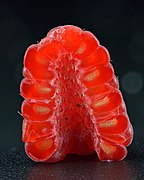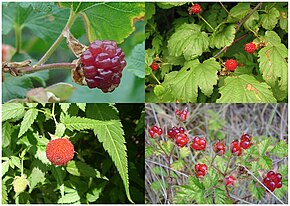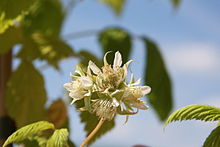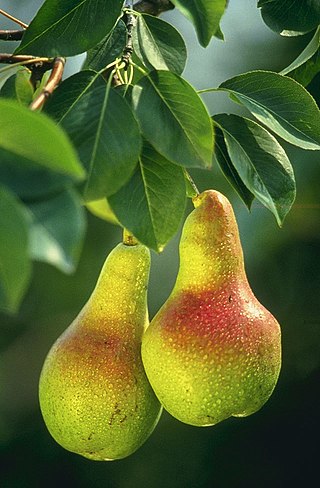
Pears are fruits produced and consumed around the world, growing on a tree and harvested in late summer into mid-autumn. The pear tree and shrub are a species of genus Pyrus, in the family Rosaceae, bearing the pomaceous fruit of the same name. Several species of pears are valued for their edible fruit and juices, while others are cultivated as trees.
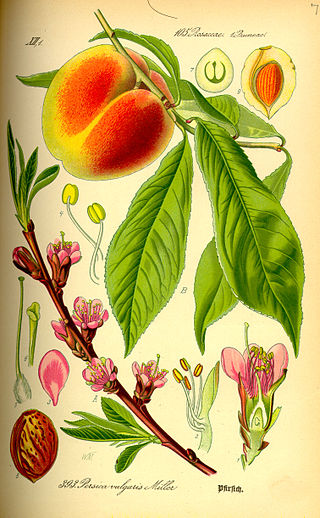
The peach is a deciduous tree first domesticated and cultivated in Zhejiang province of Eastern China. It bears edible juicy fruits with various characteristics, most called peaches and others, nectarines.
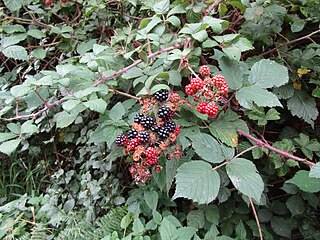
Rubus is a large and diverse genus of flowering plants in the rose family, Rosaceae, subfamily Rosoideae, with over 1,350 species, commonly known as brambles.

A cherry is the fruit of many plants of the genus Prunus, and is a fleshy drupe.
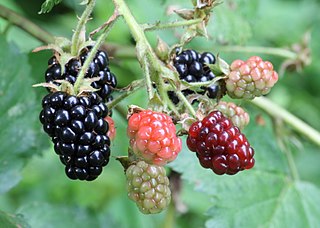
The blackberry is an edible fruit produced by many species in the genus Rubus in the family Rosaceae, hybrids among these species within the subgenus Rubus, and hybrids between the subgenera Rubus and Idaeobatus. The taxonomy of blackberries has historically been confused because of hybridization and apomixis, so that species have often been grouped together and called species aggregates. For example, the entire subgenus Rubus has been called the Rubus fruticosus aggregate, although the species R. fruticosus is considered a synonym of R. plicatus.

Vaccinium vitis-idaea, the lingonberry, partridgeberry, mountain cranberry or cowberry, is a small evergreen shrub in the heath family Ericaceae, that bears edible fruit. It is native to boreal forest and Arctic tundra throughout the Northern Hemisphere, from Europe and Asia to North America. Lingonberries are picked in the wild and used to accompany various dishes, primarily in the Nordic countries. Commercial cultivation is undertaken in the U.S. Pacific Northwest and in the Netherlands.

The boysenberry is a cross between the European raspberry, European blackberry, American dewberry, and loganberry.

Rubus idaeus is a red-fruited species of Rubus native to Europe and northern Asia and commonly cultivated in other temperate regions.

Rubus spectabilis, the salmonberry, is a species of bramble in the rose family Rosaceae, native to the west coast of North America from west-central Alaska to California, inland as far as Idaho. Like many other species in the genus Rubus, the salmonberry plant bears edible fruit, typically yellow-orange or red in color, resembling raspberries in appearance.

The loganberry is a hybrid of the North American blackberry and the European raspberry.

The marionberry is a cultivar of blackberry released in 1956 by the USDA Agricultural Research Service breeding program in cooperation with Oregon State University. It is named after Marion County, Oregon, where the berry was bred and tested extensively in the mid-20th century.

Rubus phoenicolasius is an Asian species of raspberry in the rose family, native to China, Japan, and Korea.

Rubus caesius is a Eurasian species of dewberry, known as the European dewberry. Like other dewberries, it is a species of flowering plant in the rose family, related to the blackberry and raspberry. It is widely distributed across much of Europe and Asia from Ireland and Portugal as far east as Xinjiang Province in western China. It has also become sparingly naturalized in scattered locations in Argentina, Canada, and the United States.

Rubus occidentalis is a species of Rubus native to eastern North America. Its common name black raspberry is shared with other closely related species. Other names occasionally used include bear's eye blackberry, black cap, black cap raspberry, and scotch cap.

Pyrus communis, the common pear, is a species of pear native to central and eastern Europe, and western Asia.

Rubus strigosus, the American red raspberry or American raspberry, is a species of Rubus native to much of North America. It was often treated as a variety or subspecies of the closely related Eurasian Rubus idaeus, but is now more commonly treated as a distinct species. Many of the commercial raspberry cultivars grown for their fruit derive from hybrids between R. strigosus and R. idaeus; see Raspberry for more details.
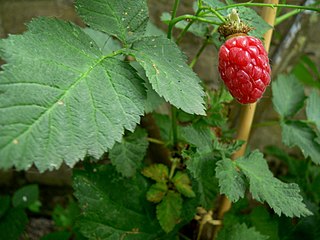
The tayberry is a cultivated shrub in the genus Rubus of the family Rosaceae patented in 1979 as a cross between a blackberry and a red raspberry, and named after the River Tay in Scotland.

Rubus armeniacus, the Himalayan blackberry or Armenian blackberry, is a species of Rubus in the blackberry group Rubus subgenus Rubus series Discolores Focke. It is native to Armenia and northern Iran, and widely naturalised elsewhere. Both its scientific name and origin have been the subject of much confusion, with much of the literature referring to it as either Rubus procerus or Rubus discolor, and often mistakenly citing its origin as western European. Flora of North America, published in 2014, considers the taxonomy unsettled, and tentatively uses the older name Rubus bifrons.

Raspberry spur blight is caused by the fungus Didymella applanata. This plant pathogen is more problematic on red raspberries (Rubus idaeus) than on black or purple raspberries. The fungus infects the leaves first and then spreads to the cane. It causes necrotic spots on the cane near the base of the petiole attachment. Raspberry spur blight can cause a significant reduction in yield, fruit blight, premature leaf drop, and weak bud and cane growth. The magnitude of damage is not clearly understood in the United States, however, studies from Scotland suggest damage to the cane itself is limited. The disease has minor economic impacts by reducing leaves in the summer or killing buds. Major economic damage occurs if the disease manages to kill the entire cane. In the United States, this disease is found in Oregon and Washington.




